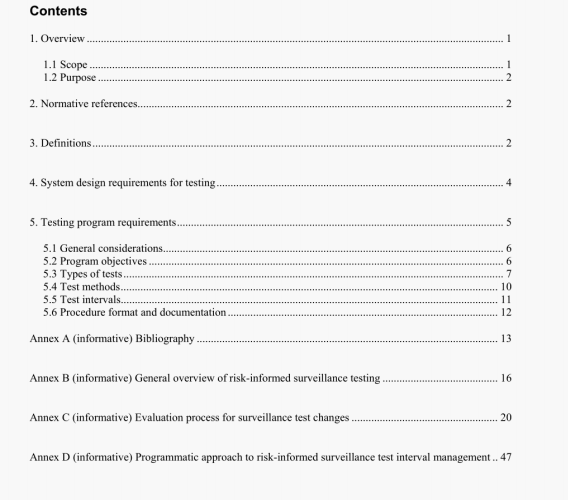IEEE 338:2006 pdf free download.IEEE Standard Criteria for Periodic Surveillance Testing of Nuclear Power Generating Station Safety Systems.
5.3.2 Functional tests
A functional test shall assure thai the tested equipment is capable of perfonning its design function. The test should neither be lengthy nor require extensive rest equipment or personnel.
a) A functional test for equipment (system components) shall consist, as appropriate. of one or more of the following:
I) Manually starling equipment (for example. motor, pump. compressor. turbine, or engine) and observing proper operation (for example, pressure. flow, temperature. voltage, or speed). Test duration shall be sufficient to achieve stable operating conditions. Where starting a pump or other equipment is not practical, test operation of the circuit breakers (and other equipment having provision for testing without energizing or deenergizing loads) in “test” position may be acceptable if the requirements of item e) and item o) of Clause 4 are met.
2) Manually controlling electric operation of valves and other components, if appropriate. In cases where fully stroking the valve is not practical. a partial stroke lest (for example, main steam stop valves, turbine stop, or control valves) or a valve control system test (for example, the control circuit for explosive poison injection valves) may be acceptable. Full stroke testing should be routinely accomplished during plant shutdown periods where practicable.
3) Injecting test signals of an appropriate magnitude to give an approximate indication (for example, a numerical output “equivalent” to tripping the output) or tripping the output. or doing both. Alarm and trip functions, and other indications as applicable, shall be tested.
b) Testing to verify the system or subsystem function shall include, as appropriate:
1) Individually tripping actuating devices and observing proper load group operation (for example, trip bus tinder-voltage relays and observe bus transfer, load shedding, diesel generator start, and load sequencing).
2) Verifying manually initiated safety functions. Where it is not possible to perform a test during plant operation, the tests may be performed during reactor shutdown (for example. manual reactor trip).
3) Testing the status and operability of bypasses. bypass and test indications, and bypass and test annunciation circuits.
4) Varying input signal levels for one or more parameters to achieve tripping or change in calculated output, while signals for other variables are maintained at their normal expected values. The parameters to be varied shall be selected based on expected design basis event conditions and anticipated operational occurrences. It may be necessary to vary more than one parameter from its normal expected value.
IEEE 338:2006 pdf free download
